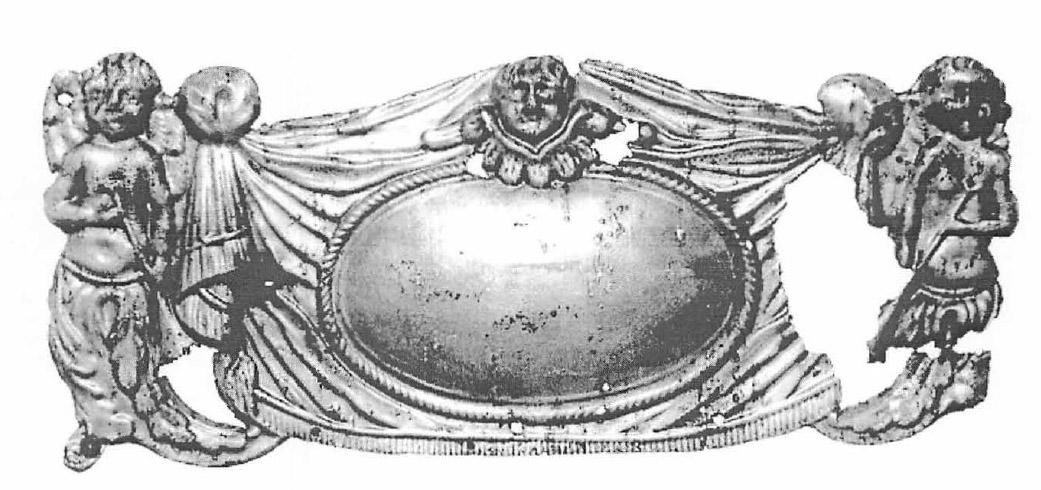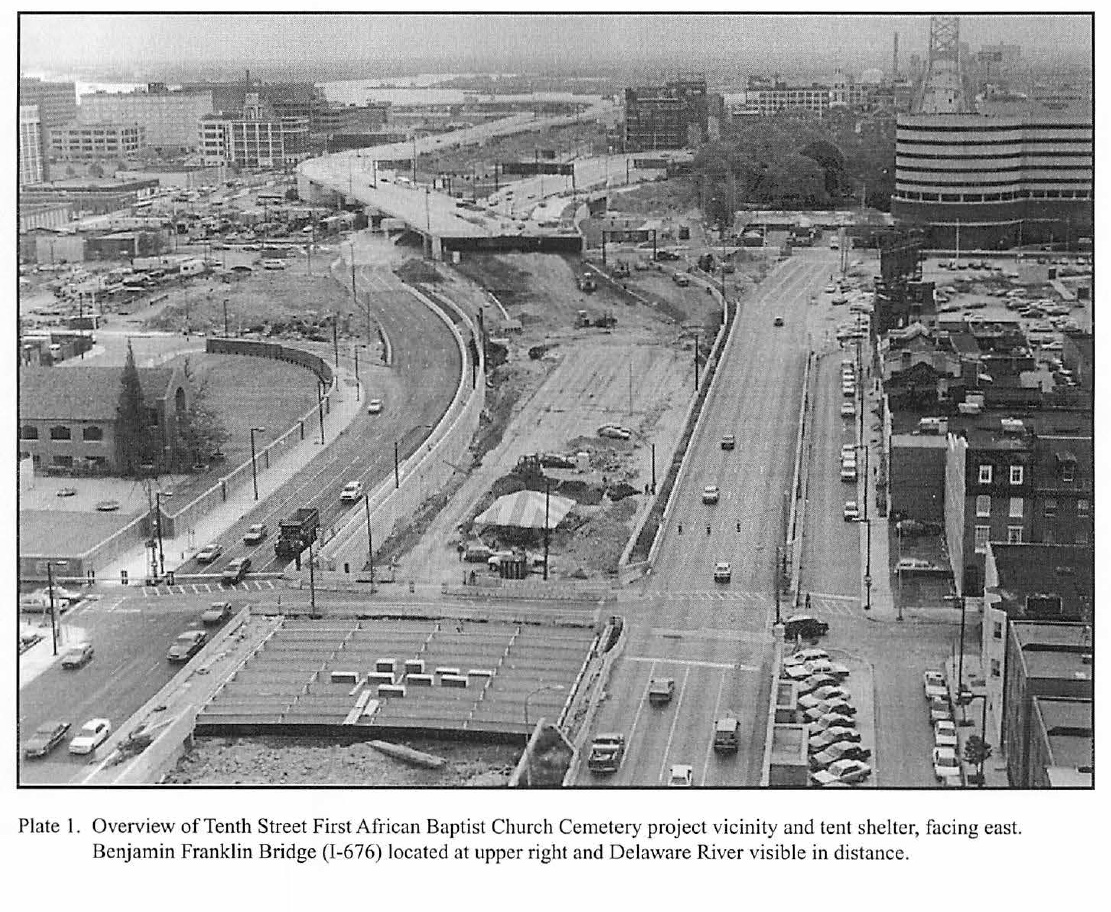February 2018 – Artifact of the Month
To PAF Home
To Artifact of the Month Index
To Burial Places Forum
~~~
Mortuary Decoration:
A 19th-Century, African American Example From Philadelphia

Coffin Hardware recovered from a burial excavated more than two decades ago at the location of the Tenth Street African Baptist Church Burial Ground (dating 1810-1822). Size: 8-l /4 in. long by 3.114 inches in height. The molded design depicts angels standing on either end of the plate with a single cherub head over a plain, flat oval center. Each angel holds a trumpet, presumed to be the Trumpet of Gabriel. Such plates, made of a white metal alloy, were fastened to the coffin wood with tacks. The handles could not have been used to carry the coffin, making the lug plates ornamental rather than functional.
(*The following archaeological report ABSTRACT is edited and annotated here by the PAF web master to assist non-archaeological audiences.)
In April and May, 1990, an archeological project took place at Tenth and Vine Streets in Philadelphia, Pennsylvania at the site of a former cemetery used by the First African Baptist Church between 1810 and 1822. The excavation of the cemetery and subsequent laboratory analysis was performed as part of the Vine Expressway (I-676) Construction Project, undertaken by the Pennsylvania Department of Transportation and the Federal Highway Administration.
The skeletal remains and funerary artifacts of 89 African-American individuals were recovered from the site, including 56 adults (38 females and 18 males) and 33 infants and children. The goals of the anthropological analyses of the excavated human and material remains were to: 1) document the biocultural responses made by the members of the congregation to the socio-economic stressors and acculturative factors that affected their lives; 2) report the results of the various studies made of the history, biology, and mortuary practices of the individuals buried at the cemetery; and 3) document the formation processes through which the site was transformed from a rural cemetery on the edge of the city into an intensely developed 19th century urban enclave and finally a major thoroughfare.
Associated with the earliest free African-American Baptist congregation in Philadelphia, the well-preserved remains yielded information on demography, health quality, prevalence of disease and trauma, patterns of physical stress, and levels of nutritional adequacy for a group of people about which little historical documentation exists. Analysis of burial practices reflected the incorporation of Christian mortuary traditions into the African American funerary rite, while the limited use of ornamental coffin hardware provided a material link between the funeral industries in England and Philadelphia during the early 19th century. A paucity of material remains found with the interments and the use of simple wooden coffins for burial indicated the marginal economic position of this segment of early Philadelphia society, the osteological [skeleton bone] signatures of which included early onset of osteoarthritis in females, poor dental health among all sex and age subgroups, high frequencies of periostitis among both adults and children [inflammation of the membranes enveloping bone], and a high frequency of lesions related to poor nutrition in the remains of the children.
The historical development of the Church was found to reflect the attempts by early African Americans in Philadelphia to establish their own identity within an Anglicized society and to foster social institutions that supported African-American self-sufficiency and social cohesion. Biographies of the 13 founding members of the Church were reconstructed from Census data and other contemporaneous records, which also revealed details of the history of the Church after it lost its cemetery property at a sheriffs sale in 1822.
The Tenth Street First African Baptist Church Cemetery Project was a successful partnership between public agencies, private companies, archeologists and physical anthropologists, and members of the descendant community. Religious and social concerns were considered equally along with scientific perspectives throughout the entire decision-making process, and an intensive educational outreach program was instituted to involve members of the Philadelphia community in the project. An Oversight Committee of professional anthropologists was formed to guide the analyses of the human remains, while the current Church congregation was actively involved in decisions regarding the types of analyses performed and preparations for reburial of the human remains. The project served to demonstrate the benefits of such a partnership in terms of increasing knowledge about our past and engendering a modern African-American identity, while also illustrating the potential of historic cemeteries to yield information about American social history and the urban experience unavailable from other sources.
The above text is an *abbreviated version of the ABSTRACT for the report named below.

Prepared for Gaudet & O’Brien Associates/ Urban Engineers, Incorporated
300 North 3rd Street, Philadelphia, Pennsylvania 19106-1193
and
Department of Transportation, Commonwealth of Pennsylvania
Engineering District 6-0, 200 Radnor-Chester Road
St. Davids, Pennsylvania 19087
by
Thomas A.J. Crist, Reginald H. Pitts, Arthur Washburn, John P. McCarthy, Daniel G. Roberts
With Contributions By Molly A. Hickey, Rashid M. Humphrey
John Milner Associates, Inc., 1216 Arch Street, 5th Floor
Philadelphia, Pennsylvania 19107
1996

[Due to its size, this report is not accessible directly online at this time. Please contact the PAF web Master at pljeppson@gmail.com to request a copy be emailed.
Read here about an exhibit mounted by the African American Museum of Philadelphia (‘Digging Up The Past: First African Baptist Church Burial Grounds’) which drew upon this archaeological research.
For a discussion about mortuary iconography in archaeological research see Edward L. Bell’s The Historical Archaeology of Mortuary Behavior: Coffin Hardware from Uxbridge, Massachusetts.
—-
(Our thanks to John McCarthy for providing the PAF web page a copy of the Vine Street/Baptist Church Burial Grounds report – the source for this featured artifact write up.)
by admin